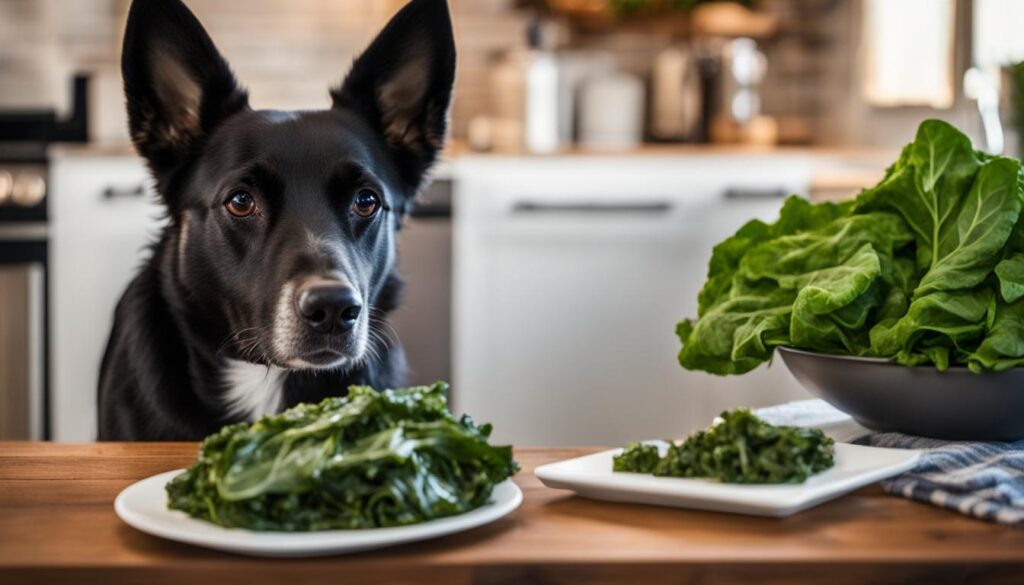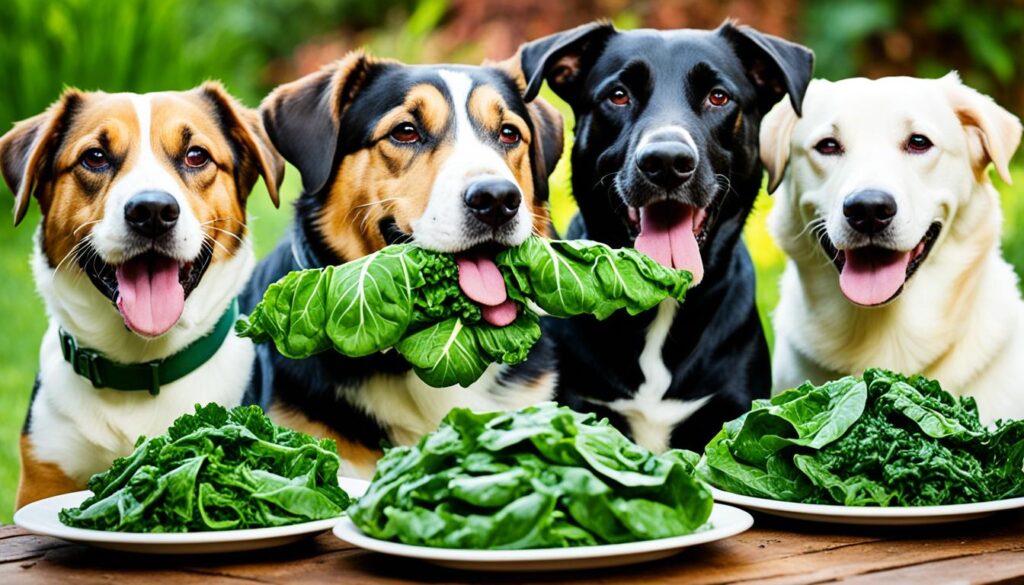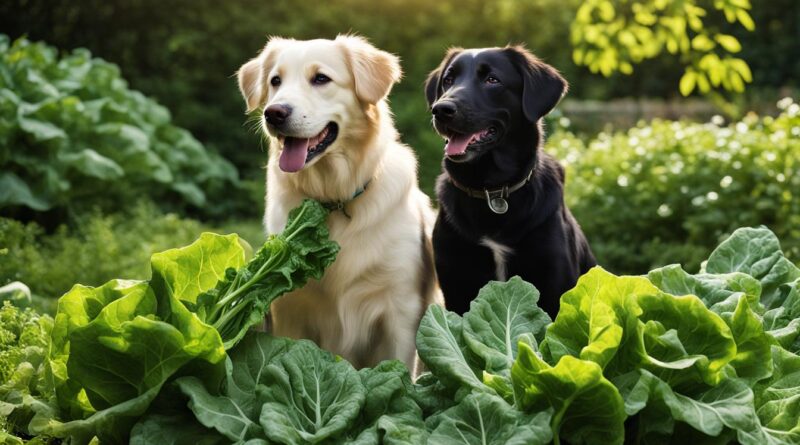Can Dogs Eat Collard Greens? Safety & Tips
Collard greens are a popular leafy green vegetable that is enjoyed by many humans. But can our furry friends, dogs, safely consume collard greens? In this article, we will explore the safety of collard greens for dogs and provide you with tips on how to incorporate this nutritious vegetable into your dog’s diet.
Collard greens belong to the brassica oleracea family and are packed with essential nutrients, including protein, calcium, iron, magnesium, potassium, vitamin A, vitamin C, and vitamin K. These nutrients can offer a range of health benefits for dogs when consumed in moderation.
When feeding collard greens to your dog, it is crucial to prepare them properly. Fresh collard greens should be steamed or boiled before serving, as raw greens may be difficult for dogs to digest. Additionally, it is important to remove the tough stems before offering collard greens to your furry friend.
While collard greens can provide valuable nutrients to your dog, there are certain instances when they should be avoided. Dogs with bladder or kidney stones or those prone to developing them should not be fed collard greens due to compounds that could contribute to stone formation. It’s always best to consult with a veterinarian before making any dietary changes for your dog.
Key Takeaways:
- Collard greens are safe for dogs to eat in moderation.
- They are rich in nutrients such as protein, calcium, iron, magnesium, potassium, vitamin A, vitamin C, and vitamin K.
- Cook collard greens before serving them to dogs to aid in digestion.
- Remove the tough stems from collard greens before feeding them to dogs.
- Consult with a veterinarian before introducing collard greens to dogs with existing urinary issues or health conditions.
Are Collard Greens Safe for Dogs?
Collard greens are safe for dogs to eat, but it is important to feed them in moderation and take certain precautions. Dogs should not consume collard greens that have been canned or seasoned with spices, as these may contain additives and high levels of sodium that can be harmful to their health.
When including collard greens in a dog’s diet, it is essential to remove the tough stems before feeding them to your furry friend. The stems can be difficult for dogs to chew and may pose a choking hazard. By removing the stems, you can ensure that your dog can safely enjoy the nutritious benefits of collard greens.
Cooking the collard greens is also recommended when feeding them to dogs. Raw collard greens can be challenging for dogs to digest and may lead to digestive upset. Steaming or boiling the collard greens will make them softer and more easily digestible for your canine companion.
As with any new food, it is crucial to introduce collard greens gradually into your dog’s diet. Start with small portions to ensure that your dog tolerates them well and does not experience any adverse reactions. If you notice any digestive issues or allergies, discontinue feeding collard greens and consult with your veterinarian.
What Are the Health Benefits of Collard Greens for Dogs?
Collard greens offer various health benefits for dogs. They are nutrient-dense and can provide protein, calcium, iron, magnesium, potassium, vitamin A, vitamin C, and vitamin K. Collard greens are prebiotic fiber that aids in digestive health, can help lower cholesterol levels, reduce the risk of heart disease and cancer, improve blood health, support joint health, and contribute to a youthful appearance.
How to Feed Collard Greens to Dogs
When it comes to incorporating collard greens into your dog’s diet, proper preparation is key to ensure they are easily digestible. Raw collard greens can be challenging for dogs to digest and may lead to stomach upset. To avoid any potential issues, it is recommended to steam or boil fresh collard greens before adding them to your dog’s bowl.
Properly cooked collard greens:
- Are easier for dogs to digest
- Help release crucial nutrients
- Minimize the risk of digestive discomfort
The amount of collard greens given to a dog should be based on their size. Smaller dogs should receive smaller portions, while larger dogs can be given slightly more. It is important to introduce collard greens gradually into your dog’s diet, starting with small quantities, and monitor their response.
Feeding collard greens to your dog:
- Steam or boil fresh collard greens until they are soft and tender.
- Allow the collard greens to cool down before serving them to your dog.
- Chop the collard greens into small, manageable pieces to prevent choking hazards.
- Mix the collard greens with your dog’s regular food or use them as a healthy treat.
Remember that collard greens should be incorporated as part of a balanced diet and not be the sole focus of your dog’s meals. Consult with your veterinarian for specific feeding guidelines based on your dog’s individual needs.
Expert Tip:
“Properly cooked collard greens provide a nutritious boost to your dog’s diet. When introducing collard greens, keep an eye out for any signs of digestive issues or allergies. It’s always best to consult with your veterinarian to ensure your dog’s dietary needs are met.”
– Dr. Sarah Thompson, DVM
When Not to Feed Collard Greens to Dogs
While collard greens are generally safe for dogs, there are certain circumstances in which they should be avoided. One such situation is if a dog has bladder or kidney stones or is prone to developing them. Collard greens contain compounds that can contribute to stone formation, leading to discomfort and potential health complications for the dog.
It is crucial to consult with a veterinarian before including collard greens in a dog’s diet, especially if the dog has pre-existing urinary issues. The veterinarian will be able to assess the dog’s individual health condition and provide appropriate guidance on whether or not it is safe to feed collard greens.
While collard greens offer numerous health benefits, including vitamins, minerals, and dietary fiber, it is always essential to prioritize a dog’s well-being and consult with a professional. By ensuring the dog’s specific needs and health conditions are considered, pet owners can provide a safe and balanced diet for their furry companions.
Can Dogs Eat Cooked Collard Greens?
When it comes to including collard greens in a dog’s diet, opting for the cooked variety is the safest choice. Cooked collard greens are easier for dogs to digest, making them a suitable addition to their meals. However, it’s important to keep in mind a few guidelines to ensure the health and well-being of your furry friend.
Preparing Cooked Collard Greens for Dogs
When preparing cooked collard greens for dogs, it’s crucial to avoid adding any seasonings, garlic, onions, or excessive salt. These ingredients can be harmful to dogs and should be avoided at all costs. Instead, focus on simple cooking methods that retain the nutritional value of the greens.
Steaming or sautéing fresh collard greens is recommended, as these methods maintain the natural flavors and nutrients while making the greens more palatable for dogs. Both techniques allow the collard greens to soften, making them easier to chew and digest.
Remember to chop the leaves into small, bite-sized pieces before serving them to your furry companion. This ensures that the greens are easier to handle and reduces the risk of choking or digestive discomfort.

Feeding your dog cooked collard greens in moderation can be a healthy way to introduce additional nutrients into their diet. However, collard greens should never replace a balanced and complete commercial dog food. Always consult with a veterinarian before making any significant changes to your dog’s diet.
Can Dogs Eat Canned Collard Greens?
In the question of whether dogs can eat collard greens, it’s important to note that canned collard greens should be avoided when including this leafy green in your furry friend’s diet. While collard greens themselves are generally safe for dogs, the canned variety often contains excessive salt and preservatives that can be harmful to their health.
Fresh, cooked collard greens are the best option when it comes to feeding them to your dog. By sticking to fresh collard greens that are prepared without any additives or seasonings, you can ensure that your dog receives all the benefits of this nutritious green without any unnecessary risks.

Nutritional Comparison: Fresh Collard Greens vs. Canned Collard Greens
| Nutrient | Fresh Collard Greens (per 100g) | Canned Collard Greens (per 100g) |
|---|---|---|
| Calories | 32 | 56 |
| Protein (g) | 2 | 2.2 |
| Fat (g) | 0.4 | 1.3 |
| Carbohydrates (g) | 7 | 7.4 |
| Fiber (g) | 4 | 3.6 |
| Calcium (mg) | 232 | 98 |
| Iron (mg) | 0.6 | 1.6 |
| Magnesium (mg) | 17 | 16 |
| Potassium (mg) | 213 | 187 |
| Vitamin A (IU) | 4811 | 409 |
| Vitamin C (mg) | 35.3 | 0 |
| Vitamin K (mcg) | 366 | 253 |
While the nutritional content may vary depending on the specific brand and processing methods, the table above provides a general comparison between fresh collard greens and canned collard greens. It is clear that fresh collard greens offer a higher concentration of nutrients, making them the superior option for your dog’s diet.
When it comes to the health and well-being of our beloved pets, it’s always best to choose the freshest and most natural options available. By sourcing fresh collard greens and preparing them in a dog-friendly manner, you can ensure that your furry friend enjoys all the benefits of this nutrient-rich green without any potential risks associated with canned alternatives.
Conclusion
Collard greens can be a safe and nutritious addition to a dog’s diet. These leafy greens are packed with essential nutrients such as protein, calcium, iron, magnesium, potassium, vitamin A, vitamin C, and vitamin K. Dogs can benefit from the digestion-promoting properties of collard greens, as well as their potential to lower cholesterol, reduce the risk of heart disease and cancer, support blood health, improve joint health, and contribute to a youthful appearance.
When feeding collard greens to dogs, it is important to cook them first to ensure easy digestion. Steamed or boiled fresh collard greens are recommended, without any additives or seasonings. It’s crucial to consult with a veterinarian before introducing collard greens to a dog’s diet, especially if the dog has any pre-existing health conditions.
Remember, moderation is key when incorporating collard greens into a dog’s diet. Start with small amounts and observe how your dog reacts. If there are any signs of digestive upset or other adverse reactions, discontinue feeding collard greens and consult with your vet.
FAQ
Can dogs eat collard greens?
Yes, collard greens are safe for dogs to eat in moderation.
What are the health benefits of collard greens for dogs?
Collard greens are rich in nutrients such as protein, calcium, iron, magnesium, potassium, vitamin A, vitamin C, and vitamin K. They can promote digestive health, lower cholesterol levels, reduce the risk of heart disease and cancer, improve blood health, support joint health, and contribute to a youthful appearance in dogs.
How should I feed collard greens to my dog?
It is recommended to steam or boil fresh collard greens before adding them to a dog’s bowl. The amount given should be based on the dog’s size, with smaller dogs receiving less and larger dogs receiving more.
Are collard greens safe for dogs?
Yes, collard greens are safe for dogs to eat. However, it is important to avoid canned or seasoned collard greens and to remove the tough stems before feeding them to dogs.
Can dogs eat cooked collard greens?
Yes, cooked collard greens are safe for dogs to eat. It is important to avoid adding any seasonings, garlic, onions, or excessive salt when preparing them for dogs.
Can dogs eat canned collard greens?
No, canned collard greens should be avoided when feeding them to dogs. Canned collard greens often contain excessive salt and preservatives, which can be harmful to dogs.

